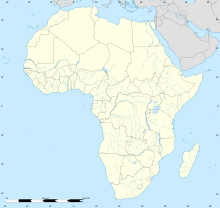
Back عملية الثعبان القوطي Arabic Operace Gothic Serpent Czech Operation Gothic Serpent Italian Operasjon Gotisk Slange NB Operação Serpente Gótica Portuguese Операція «Готичний змій» Ukrainian
| Operation Gothic Serpent | |||||||
|---|---|---|---|---|---|---|---|
| Part of the Somali Civil War and the UNOSOM II mission | |||||||
 Bravo Company, 3rd Battalion, 75th Ranger Regiment in Somalia, 1993. | |||||||
| |||||||
| Belligerents | |||||||
| Commanders and leaders | |||||||
|
|
| ||||||
| Units involved | |||||||
|
|
| ||||||
| Strength | |||||||
|
441 troops[10] 8 MH-60 Black Hawks 4 AH-6 4 MH-6 Little Birds[7] 3 OH-58 Kiowas 1 P-3 Orion[6] HMMWVs 5-ton trucks[11] |
Several thousand militiamen and volunteers[12] Multiple technicals | ||||||
| Casualties and losses | |||||||
Location of the operation within Somalia Mogadishu, Somalia, shown relative to the rest of Africa | |||||||
Operation Gothic Serpent was a military operation conducted in Mogadishu, Somalia, by an American force code-named Task Force Ranger during the Somali Civil War in 1993. The primary objective of the operation was to capture Mohamed Farrah Aidid, leader of the Somali National Alliance who was wanted by the UNOSOM II in response to his attacks against United Nations troops. The operation took place from August to October 1993 and was led by US Joint Special Operations Command (JSOC).
On 3 October 1993, the task force executed a mission to capture two of Aidid's lieutenants. The mission ultimately culminated in what became known as the Battle of Mogadishu. The battle was extremely bloody and the task force inflicted significant casualties on Somali militia forces, while suffering heavy losses themselves. The Malaysian, Pakistani, and conventional US Army troops under UNOSOM II which aided in TF Ranger's extraction suffered losses as well, though not as heavy. The intensity of the battle prompted the effective termination of the operation on 6 October 1993. This was followed by the withdrawal of TF Ranger later in October 1993, and then the complete exit of American troops in early 1994.[2][3][1]
The repercussions of this encounter substantially influenced American foreign policy, culminating in the discontinuation of the UNOSOM II by March 1995.[5] At the time, the Battle of Mogadishu was the most intense, bloodiest single firefight involving US troops since Vietnam.[19][20]
- ^ a b Ecklund, Marshall (2004). "Task Force Ranger vs. Urban Somali Guerrillas in Mogadishu: An Analysis of Guerrilla and Counterguerrilla Tactics and Techniques used during Operation GOTHIC SERPENT". Small Wars & Insurgencies. 15 (3): 47–69. doi:10.1080/0959231042000275560. ISSN 0959-2318. S2CID 144853322.
- ^ a b Walker, Martin (20 October 1993). "Crack US troops to leave Somalia". The Guardian. Archived from the original on 3 June 2023. Retrieved 3 June 2023.
- ^ a b Marcus, Ruth; Lancaster, John (20 October 1993). "U.S. PULLS RANGERS OUT OF SOMALIA". The Washington Post. Archived from the original on 10 September 2023. Retrieved 3 June 2023.
- ^ Cite error: The named reference
atkinson 01-94was invoked but never defined (see the help page). - ^ a b c US forces, Somalia AAR 2003, p. 13.
- ^ a b c d Bowden 1999, p. 11.
- ^ a b Piasecki 2007.
- ^ Haulman 2015, p. 11.
- ^ Day 1997, p. 17.
- ^ Task Force Ranger AAR 1994, p. 3.
- ^ Bowden 1999, p. 5.
- ^ Loeb 2000.
- ^ Bowden 1999, p. 301.
- ^ Poole 2005, p. 57.
- ^ Cite error: The named reference
malaywas invoked but never defined (see the help page). - ^ Task Force Ranger AAR 1994, p. 12.
- ^ "Interviews – Captain Haad | Ambush in Mogadishu | Frontline". PBS. 3 October 1993. Archived from the original on 13 November 1999. Retrieved 25 August 2013.
- ^ Bowden 1999, p. 333.
- ^ Dauber, Cori Elizabeth (2001). "The Shot Seen 'Round the World: The Impact of the Images of Mogadishu on American Military Operations". Rhetoric & Public Affairs. 4 (4): 653–687. doi:10.1353/rap.2001.0066. S2CID 153565083.
- ^ Olson, Bryan W.; Ortega Sr., Gary L. (30 June 2009). "The Battle of Mogadishu, 3 Oct 93" (PDF). Defense Technical Information Center. United States Army Sergeants Major Academy. Archived from the original (PDF) on 9 August 2022.
Cite error: There are <ref group=lower-alpha> tags or {{efn}} templates on this page, but the references will not show without a {{reflist|group=lower-alpha}} template or {{notelist}} template (see the help page).

